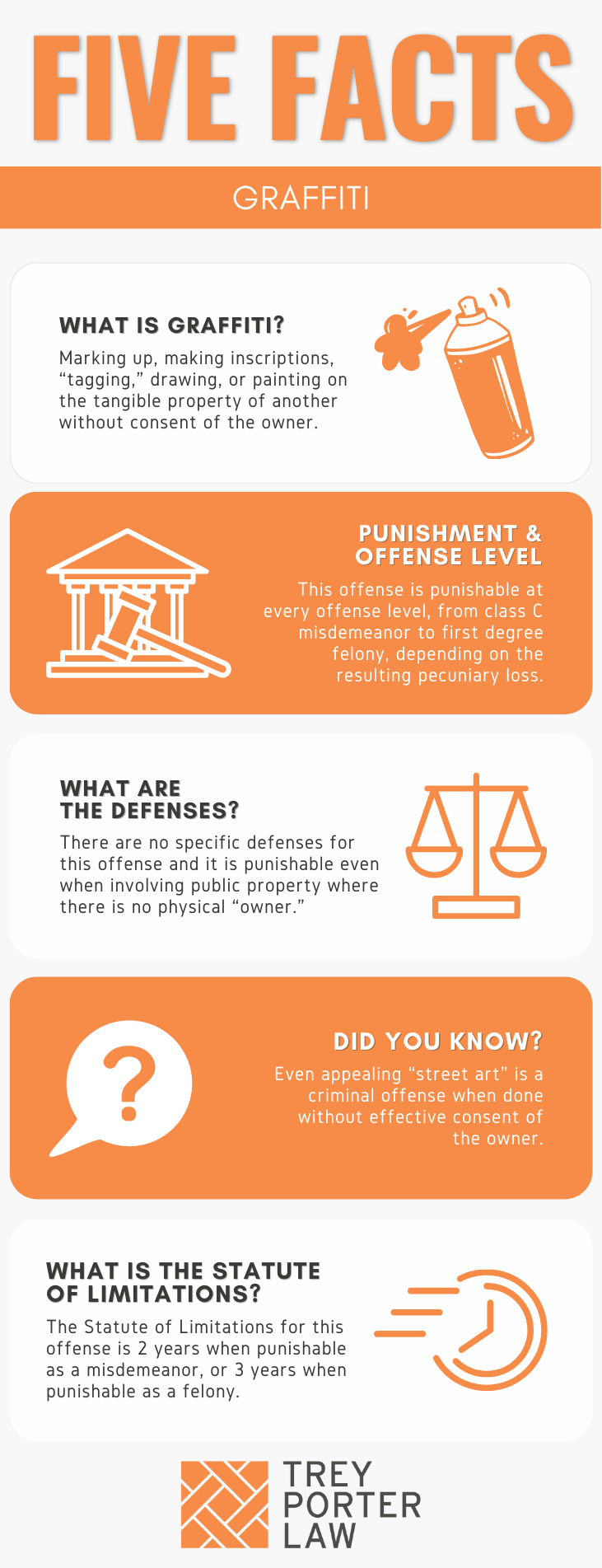WHAT IS GRAFFITI IN TEXAS?
The law against graffiti prohibits painting, inscribing, drawing on, or otherwise marking or tagging tangible property with paint, indelible marker, or an etching or engraving device without the owner’s effective consent.
- Is all graffiti illegal? No. Texas law only prohibits graffiti if it is without the property owner’s consent. Texas Penal Code Section 1.07(35) defines “owner” as “a person who has title to the property, possession of the property, whether lawful or not, or a greater right to possession of the property than the actor.”A business owner may permit artists to paint murals on the building’s exterior or fence. But spray painting or otherwise damaging a sign or barricade on the highway is a criminal offense, because the state and its political subdivisions have the authority to regulate highways and roads. See, e.g., Tex. Transp. Code § 472.021.
WHAT IS THE GRAFFITI LAW IN TEXAS?
Tex. Penal Code § 28.08. GRAFFITI.
(a) A person commits an offense if, without the effective consent of the owner, the person intentionally or knowingly makes markings, including inscriptions, slogans, drawings, or paintings, on the tangible property of the owner with:
(1) paint;
(2) an indelible marker; or
(3) an etching or engraving device.
(b) Except as provided by Subsection (d), an offense under this section is:
(1) a Class C misdemeanor if the amount of pecuniary loss is less than $100;
(2) a Class B misdemeanor if the amount of pecuniary loss is $100 or more but less than $750;
(3) a Class A misdemeanor if the amount of pecuniary loss is $750 or more but less than $2,500;
(4) a state jail felony if the amount of pecuniary loss is $2,500 or more but less than $30,000;
(5) a felony of the third degree if the amount of pecuniary loss is $30,000 or more but less than $150,000;
(6) a felony of the second degree if the amount of pecuniary loss is $150,000 or more but less than $300,000; or
(7) a felony of the first degree if the amount of pecuniary loss is $300,000 or more.
(c) When more than one item of tangible property, belonging to one or more owners, is marked in violation of this section pursuant to one scheme or continuing course of conduct, the conduct may be considered as one offense, and the amounts of pecuniary loss to property resulting from the marking of the property may be aggregated in determining the grade of the offense.
(d) An offense under this section is a state jail felony if:
(1) the marking is made on a school, an institution of higher education, a place of worship or human burial, a public monument, or a community center that provides medical, social, or educational programs; and
(2) the amount of the pecuniary loss to real property or to tangible personal property is $750 or more but less than $30,000.
Tex. Penal Code § 28.06. AMOUNT OF PECUNIARY LOSS.
(a) The amount of pecuniary loss under this chapter, if the property is destroyed, is:
(1) the fair market value of the property at the time and place of the destruction; or
(2) if the fair market value of the property cannot be ascertained, the cost of replacing the property within a reasonable time after the destruction.
(b) The amount of pecuniary loss under this chapter, if the property is damaged, is the cost of repairing or restoring the damaged property within a reasonable time after the damage occurred.
(c) The amount of pecuniary loss under this chapter for documents, other than those having a readily ascertainable market value, is:
(1) the amount due and collectible at maturity less any part that has been satisfied, if the document constitutes evidence of a debt; or
(2) the greatest amount of economic loss that the owner might reasonably suffer by virtue of the destruction or damage if the document is other than evidence of a debt.
(d) If the amount of pecuniary loss cannot be ascertained by the criteria set forth in Subsections (a) through (c), the amount of loss is deemed to be greater than $750 but less than $2,500.
(e) If the actor proves by a preponderance of the evidence that he gave consideration for or had a legal interest in the property involved, the value of the interest so proven shall be deducted from:
(1) the amount of pecuniary loss if the property is destroyed; or
(2) the amount of pecuniary loss to the extent of an amount equal to the ratio the value of the interest bears to the total value of the property, if the property is damaged.
WHAT IS THE PENALTY CLASS FOR GRAFFITI IN TEXAS?
The penalty classification for graffiti depends on the character of the property, and the amount of pecuniary loss caused by repairing or restoring the damaged property.
- Class C misdemeanor, punishable by a fine of up to $500, if:
- the pecuniary loss is less than $100,
- Class B misdemeanor, punishable by up to 180 days in county jail, if:
- the pecuniary loss is $100 or more but less than $750;
- Class A misdemeanor, punishable by up to one year in county jail, if:
- the pecuniary loss is $750 or more but less than $2,500;
- State jail felony, punishable by 180 days to two years in a state jail facility, if:
- the pecuniary loss is $2,500 or more but less than $30,000; or
- the pecuniary loss is $750 or more but less than $30,000, and the marked property is a:
- school or institution of higher education;
- place of worship or human burial;
- public monument; or
- community center that provides medical, social, or education programs;
- Third degree felony, punishable by two to ten years in prison, if:
- the pecuniary loss is $30,000 or more but less than $150,000; or
- Second degree felony, punishable by two to 20 years in prison, if:
- the pecuniary loss is $150,000 or more but less than $300,000;
- First degree felony, punishable by five to 99 years in prison, if:
- the pecuniary loss is $300,000 or more.
WHAT IS THE PUNISHMENT RANGE FOR GRAFFITI IN TEXAS?
The punishment range for graffiti increases depending on the character or value of the damaged property:
- Class C misdemeanor, if the pecuniary loss is less than $100:
- maximum fine of $500, no jail time;
- Class B misdemeanor, if the pecuniary loss is $100 or more but less than $750:
- up to 180 days in jail, maximum fine of $2,000;
- Class A misdemeanor, if the pecuniary loss is $750 or more but less than $2,500:
- up to one year in jail, maximum fine of $4,000;
- State jail felony, if the pecuniary loss is $2,500 or more but less than $30,000, or is one of the listed property types qualifying as a state jail felony offense:
- 180 days to two years in a state jail facility, maximum fine of $10,000;
- Third degree felony, if the pecuniary loss is $30,000:
- two to ten years in prison, maximum fine of $10,000;
- Second degree felony, if the pecuniary loss is $150,000 or more but less than $300,000:
- two to 20 years in prison, maximum fine of $10,000;
- First degree felony, if the pecuniary loss is $300,000 or more:
- five to 99 years or life in prison, maximum fine of $10,000.
WHAT ARE THE PENALTIES FOR GRAFFITI IN TEXAS?
A person charged with graffiti may be eligible for probation after a conviction, or deferred adjudication without a conviction. The period of community supervision depends on the offense category.
There is no community supervision required after a Class C misdemeanor conviction, but a person charged with a Class C misdemeanor graffiti may be placed on deferred adjudication for up to 180 days.
The period of community supervision for Class A or Class B misdemeanors may not exceed two years.
The period of community supervision for a state jail felony graffiti is from two to five years, with the possibility of extending supervision for up to ten years.
For a third degree felony graffiti charge, a person may be placed on deferred adjudication for up to ten years, or probation for a period between two and five years.
The period of community supervision for first degree felony and second degree felony graffiti charges may not exceed ten years. A judge may also order up to 180 days in jail as a condition of community supervision.
WHAT ARE THE DEFENSES TO GRAFFITI IN TEXAS?
The Texas graffiti statute does not authorize specific defenses to graffiti. A person accused thereof may attempt to negate one of the elements the State must prove at trial.
- What if the graffiti was on public property? Texas Penal Code Section 1.07 defines a “public place” as “any place to which the public or a substantial group of the public has access and includes, but is not limited to, streets, highways, and the common areas of schools, hospitals, apartment houses, office buildings, transport facilities, and shops.” Parks, bridges, and other open spaces may be considered public places.However, because Texas law requires cities, counties, or other designated entities to maintain certain public property, those entities are considered the “owner” under the graffiti statute. Without the owner’s consent, graffiti is illegal.In Kunz v. New York, the United States Supreme Court recognized the right of a municipality to control streets and parks. The government must permit the public to assemble, communicate thoughts, freely express religious or other views, and discuss public questions. But the government has a legitimate interest in preventing defacement or damage of property open to the public.In In re Y.S., a juvenile was convicted of graffiti after marking a park picnic table with gang signs in blue permanent marker. The arresting officer, who had patrolled that park for over three years, testified the city’s contractor who removes graffiti on city property charges on a per square foot basis for removal. Based on the size of Y.S.’s marking, the officer estimated removal would be less than $100. The appellate court affirmed Y.S.’s conviction.
- Is drawing on a school desk graffiti? Drawing on a school desk, bathroom wall, or other surface violates Texas Penal Code Section 28.08, if the markings were etched or engraved, or made with paint or indelible marker, and without the school’s consent. The school’s administration will be able to establish the cost of the desk, who sat at the desk, and that the accused did not have consent to damage the property.
WHAT IS THE STATUTE OF LIMITATIONS FOR GRAFFITI IN TEXAS?
The limitation period for graffiti classified as a misdemeanor is two years. For felony graffiti, the limitation period is three years.
GRAFFITI IN TEXAS
The Texas law against graffiti prohibits making permanent markings, tagging, etching, or engraving on another’s property without consent. Art becomes unlawful graffiti when it is done without the express consent of the person or entity who owns the property.
TEXAS GRAFFITI COURT CASES
The case law regarding graffiti in Texas aids in explaining the elements of the offense.
- In Harvey v. State, employees at the Dallas-Fort Worth International Airport noticed racial slurs written in permanent black ink on the bathroom walls. The writing could not be washed off, and had to be covered with paint. An employee monitoring the bathroom went in after seeing the defendant come out, and saw new racial slurs written in black ink on the paper towel dispenser.The appellate court upheld the defendant’s conviction. Even though the marker he used was never recovered, the evidence showing the markings were permanent and could not be erased or washed off is sufficient proof the defendant used an indelible marker.
- In Sprayberry v. State, the defendant spray-painted the word “crook” on a political sign, and was convicted of Class B misdemeanor graffiti. He argued the statute was unconstitutional because it restricted his freedom of speech, and that the evidence was legally insufficient. The appellate court affirmed the defendant’s conviction, holding the defendant’s defacement of the sign rendered it destroyed and unusable, and the owner’s testimony sufficiently established value.













